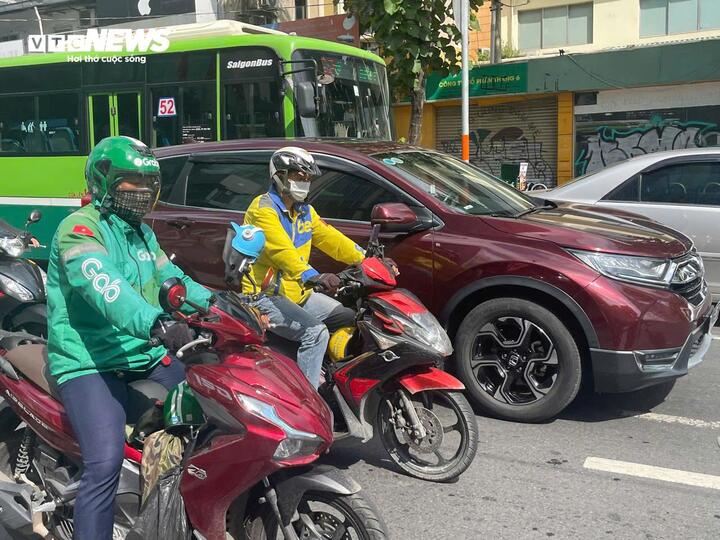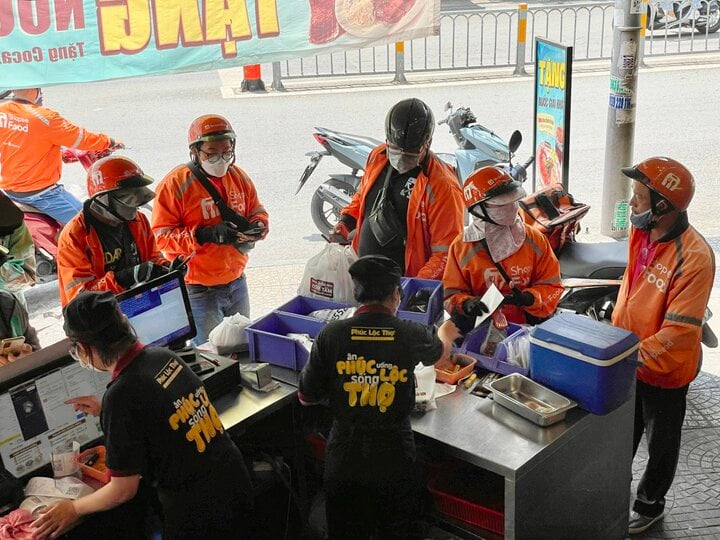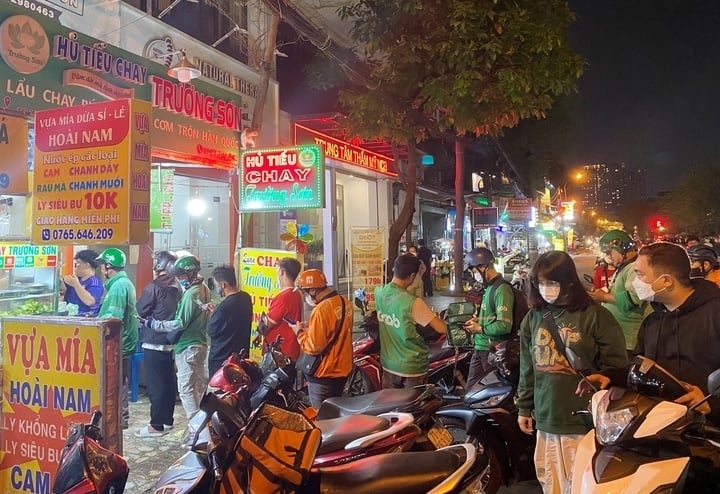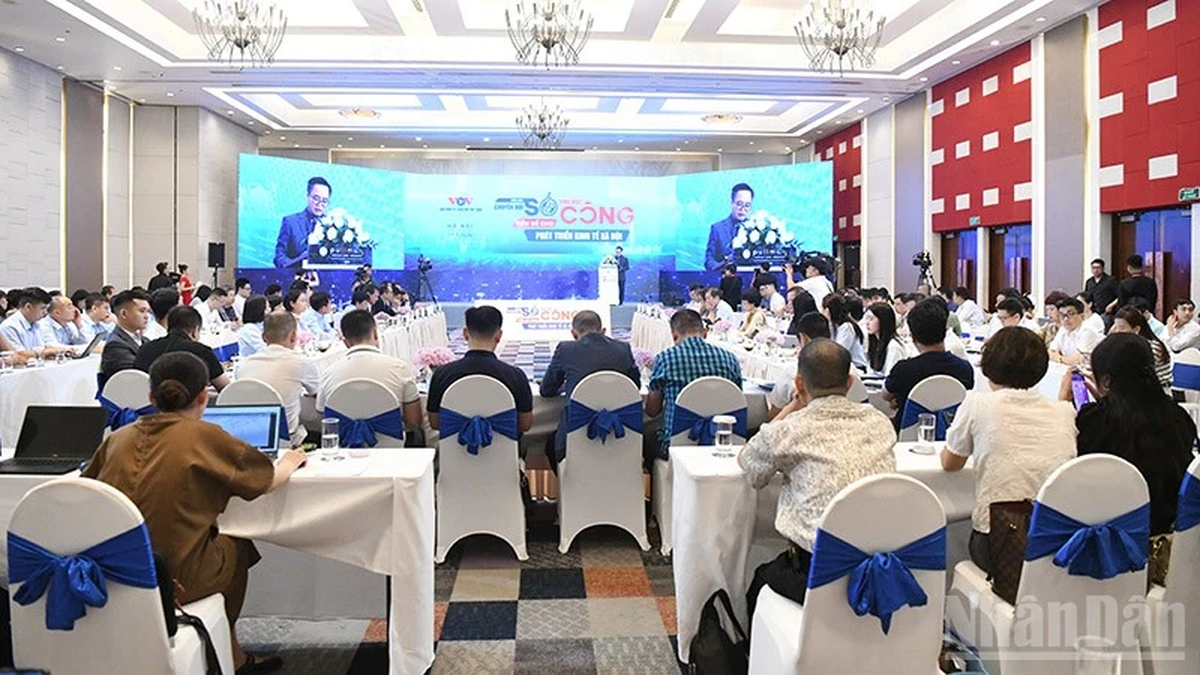Why choose 400,000 pioneering technology motorbikes?
Mr. Le Thanh Hai, Director of the Center for Economic Application Consulting - Ho Chi Minh City Institute for Development Studies, said that this week, the Institute will submit to the Ho Chi Minh City People's Committee the final draft so that the city can direct relevant units to give comments on the project to convert two-wheeled vehicles from gasoline to electric for technology drivers and delivery drivers in Ho Chi Minh City.
This project is a technical solution and an important piece of the overall traffic emission control puzzle, aiming to realize the city's strategic goals, especially the Net Zero commitment and the plan to electrify vehicles in the area. The project is expected to be implemented in January 2026.
Technology vehicles are given priority for conversion because they are the ones with the highest emissions per vehicle, including passenger and delivery vehicles.

According to a 2023 survey, each technology driver in Ho Chi Minh City travels an average of 80 - 120 km per day, with some drivers even traveling 150 km per day, 3 - 4 times more than ordinary people.
"This means that converting a technology driver's car to an electric vehicle has a much larger impact on reducing emissions than a personal two-wheeled vehicle," Mr. Hai said.
In addition, switching to electric vehicles for technology car drivers can easily create a ripple effect in society. Because this is a force that moves a lot, directly interacting with millions of people every day.
The project affirms that when technology drivers use electric vehicles with clear, clean, and economical images... it will help change public awareness and promote the need to use electric vehicles among residents.
In particular, through technology platforms such as Be, Grab, Shopee Food, Ahamove, Viettel Post... the government can quickly access, communicate, count, identify and monitor the progress of the conversion. Currently, many transport businesses are ready to convert, and have piloted the use of 2-wheel electric vehicles for drivers, ready to expand if there is a suitable policy from the State.
Switching from gasoline to electric vehicles also helps drivers save significantly on costs thanks to reduced fuel and maintenance.
"Specifically, electricity is about 80% cheaper than gasoline per km of operation; electric vehicles require less maintenance than gasoline vehicles (no oil changes, no need to maintain internal combustion engines). On average, each driver can save 1 - 1.3 million VND/month, which is a significant amount compared to the average income of technology drivers," Mr. Hai calculated.

According to the Project, all 400,000 two-wheeled gasoline vehicles currently participating in passenger transport and delivery services through technology-based transport businesses in Ho Chi Minh City (including Vung Tau and Binh Duong after the merger) will be converted to electricity.
By 2029 (the end date of the Project), the City aims to reduce 100% of polluting emissions and greenhouse gases from this group of vehicles.
4 stages of electric motorbike replacement
The project proposes 4 implementation phases, with specific goals and timelines, to create a basis for measuring and evaluating progress and effectiveness during the implementation phase. In which, phase 1 from January 2026 will convert 30%, equivalent to about 120,000 vehicles.
Phase 2 up to December 2026, the number of converted vehicles will reach 50%, equivalent to about 200,000 vehicles. Phase 3 up to December 2027, 80%, equivalent to about 320,000 technology motorbikes in the area will be converted to electric vehicles.
By December 2029, about 400,000 technology motorbikes in Ho Chi Minh City will completely switch to electric vehicles.
The five priority policy groups under this Project are financial support for technology drivers, such as VAT exemption, registration fee exemption, license plate registration fee exemption, and facilitating access to low-interest loans, without the need to mortgage assets or mortgage the assets formed from the loan, which are electric motorbikes.
The goal is to reduce financial burden, contribute to increasing income, improve working conditions for drivers, and promote the use of green vehicles in the community.
The project also recommends preferential policies for electric vehicle manufacturing and energy infrastructure development enterprises to access preferential capital sources similar to drivers, due to the large investment and high risks in the early stages. Research and development support mechanisms should also be integrated to enhance the competitiveness of domestic enterprises.

Mr. Le Thanh Hai said that the group of technology vehicle drivers is also the most vulnerable group because they are freelance workers who use motorbikes to earn a living and travel, so priority should be given to supporting a synchronous conversion with specific and clear policies, creating conditions for them to convert to safer vehicles, without leaving any people behind. If all 400,000 technology motorbikes currently converted, the basic problem would be solved.
"We compare the air quality 1.5-2 years ago with the current air quality in Ho Chi Minh City and see that it is better and less polluted. Objectively, we evaluate this, and the reason is that electric vehicles have been participating in traffic more and more, replacing gasoline vehicles. It is estimated that there are about 150,000 electric motorbikes participating in traffic in Ho Chi Minh City." Mr. Hai added.
Many concerns arise when Ho Chi Minh City switches all 400,000 gasoline motorbikes to electric vehicles, which are a group that travels a lot and requires a large amount of energy. Along with that, buses, taxis, and electric cars are operating and continue to increase, so how well the charging station infrastructure can meet the demand, experts say this is a matter of concern.
Therefore, the project also recommends that the electricity industry balance and upgrade the power grid as well as invest in charging stations to meet demand.
Data from the Department of Construction shows that by the end of 2023, Ho Chi Minh City will manage more than 8.4 million road vehicles, including more than 7.65 million motorbikes and nearly 820,000 cars of all kinds, not to mention about 2 million vehicles from neighboring localities circulating in the area. The average growth rate in the period 2015 - 2021 reached 1.84%/year for motorbikes and 6.65%/year for cars. In the total vehicle structure, motorbikes still dominate with 83.95%, followed by passenger cars with 8.1%, trucks with 4.17%... Personal vehicles continue to maintain the leading role in inner-city travel. The fact that many vehicle owners do not comply with regular maintenance and warranty schedules also contributes to the increase in toxic emissions. According to data from the Center for Air Pollution and Climate Change Research (Ho Chi Minh City National University), motorbikes alone generate about 29% of the total NO, 90% of CO, 37.7% of PM10 and 31% of PM2.5 in the whole city. The greenhouse gas inventory report also shows that the transport sector is responsible for about 45% of total greenhouse gas emissions in the area. Environmental experts warn that without early intervention, by 2030, total emissions from traffic in Ho Chi Minh City could increase 2.6 times, reaching more than 44 million tons of pollutants per year. |
Source: https://baolangson.vn/khoang-400-000-xe-may-xang-cong-nghe-o-tp-hcm-sap-chuyen-sang-xe-dien-5053481.html





































































































Comment (0)